#manfred eicher
Explore tagged Tumblr posts
Text
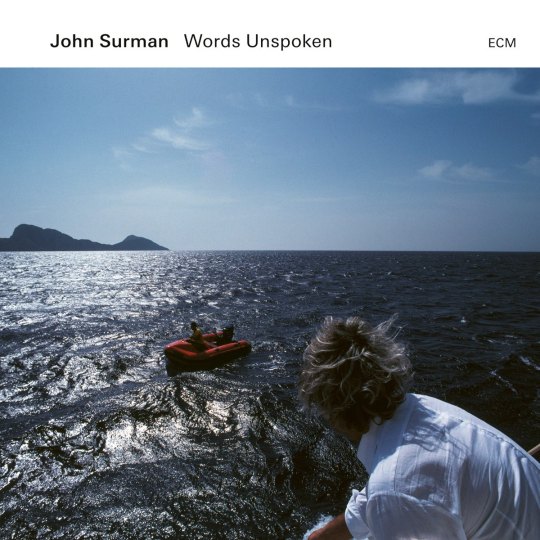
John Surman — Words Unspoken. 2024 : ECM.
#jazz#jazz saxophone#john surman#2024#ecm#multiinstrumentalist#rainbow studio#manfred eicher#2020s#2020s jazz
3 notes
·
View notes
Text
CHICK COREA AND GARY BURTON / IN CONCERT, ZÜRICH, OCTOBER 28, 1979
#music#vinyl#records#jazz#レコード#newjazzthings#ジャズ#piano#new jazz things#アナログレコード#アナログ#音楽#ニュージャズシングス#record#chick corea#gary burton#ecm#ecm records#manfred eicher#pianist#piano music#ジャズレコード
4 notes
·
View notes
Text
"Bright Size Life": The Album That Revolutionized Jazz Guitar
Introduction: Pat Metheny’s debut album, “Bright Size Life,” released in March 1976, is widely regarded as a groundbreaking work in modern jazz. This album, recorded when Metheny was just 21 years old, introduced the world to his distinctive sound, which would come to define his illustrious career. “Bright Size Life” not only announced the arrival of a fresh guitar voice but also showcased the…
#100 Jazz Albums That Shook the World#Bob Moses#Bright Size Life#Classic Albums#Gary Burton#Gary Burton Quintet#Jaco Pastorius#Jazz History#Jazz: The Smithsonian Anthology#Manfred Eicher#Ornette Coleman#Pat Metheny#Progressions: 100 Years of Jazz Guitar#Song X
3 notes
·
View notes
Text
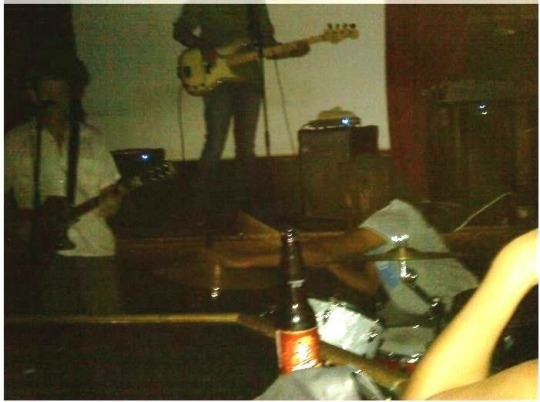
Journal 17 September 2017 - 4 October 2017, by me.
https://open.substack.com/pub/joshhaden/p/journal-17-september-2017-4-october?r=23ds5&utm_campaign=post&utm_medium=web
#charlie haden#jazz#jazz music#spain the band#don bolles#hyperion tavern#lake shrine#roberto rossellini#old and new dreams#manfred eicher#woodstock#tcm#sun kil moon#mark kozelek
3 notes
·
View notes
Text
Nils Petter Molvær - Solid Ether
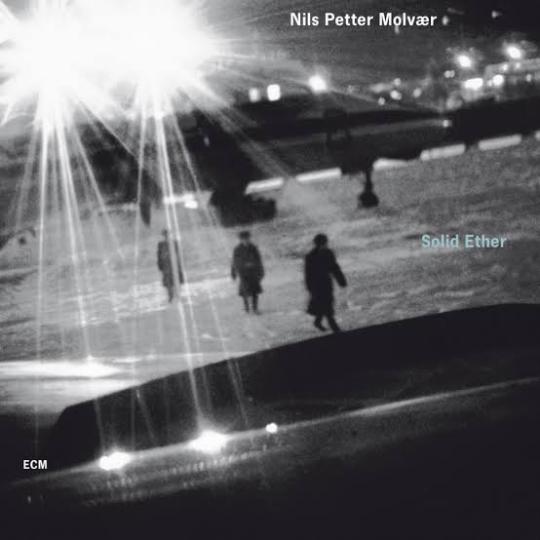
Music Video
youtube
Artist
Nils Petter Molvær
Composer
Nils Petter Molvær
Produced
Manfred Eicher
Credit
Audun Erlien - Bass Per Lindvall - Drums Rune Arnesen - Drums Eivind Aarset - Guitar, electronics Nils Petter Molvær - Trumpet, beats, sound treatment DJ Strangefruit – electronics, sampler, voice, scratches
Released
May 5 2000
Streaming
youtube
#nils petter molvær#manfred eicher#audun erlien#per lindvall#rune arnesen#eivind aarset#dj Strangefruit#2000s#2000#music#Youtube
2 notes
·
View notes
Text
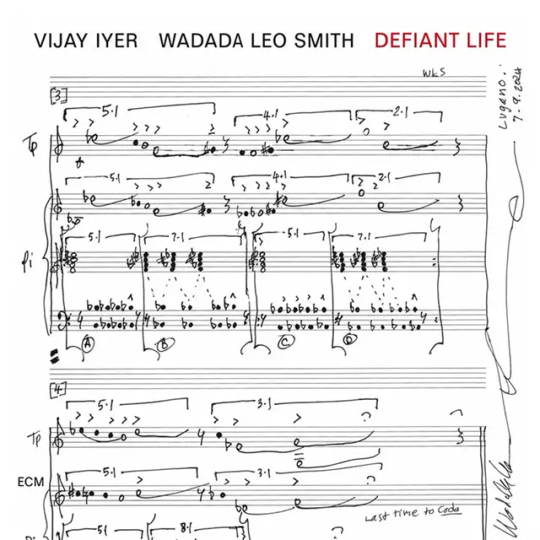
Vijay Iyer / Wadada Leo Smith - Defiant Life (ECM, 2025)
The pain humans found through life and the resilience are the topics of this album. Just piano (plus Fender Rhodes and electronics) and acoustic trumpet. All recorded, at least this is what seems to me, a little bit from a distance, in order to force the listener to get closer to the music and to himself. Music is different from the usual Smith's duets with other musicians, there's no davisian muezzin calls and no stylism. You can find a trumpet mostly curved and elliptical, accompanied by Iyer who is not descriptive but the perfect accompanist for a musician he worked so much with in the past. Highly recommended.
#Vijay Iyer#Wadada Leo Smith#Defiand Life#jazz#improvised music#contemporary music#electronics#trumpet#piano#Fender Rhodes#ECM#Manfred Eicher
0 notes
Text

John Abercrombie
Ralph Towner
Sargasso Sea
0 notes
Text
Aaron Parks Interview: Allow the Record to Show Up
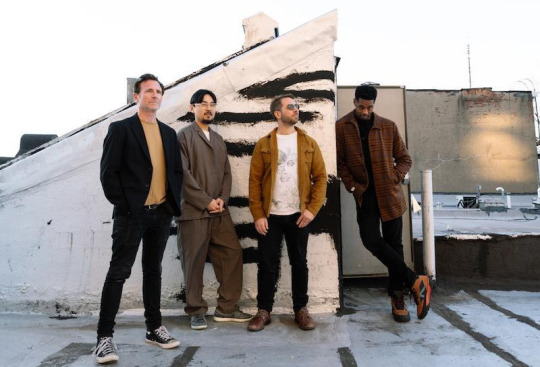
Photo by Anna Yatskevich
BY JORDAN MAINZER
Describing a record as a band's "loosest" yet is too often either a lazy euphemism for saying that it sounds incoherent or an effort to obscure the fact that it sounds the same, desperate to find a differentiator. Of course, you now know that I'm going to say that for jazz pianist Aaron Parks, the third record from his band Little Big is, for real, their loosest album. But in speaking to Parks last month over Zoom from his home in Lisbon, what I found was that there were material reasons for the album's sense of untethered security. For one, Parks and his quartet--guitarist Greg Tuohey, bassist David Ginyard Jr., and, for the first time on a studio album, drummer Jongkuk Kim--decided that though they would release Little Big III (Blue Note) under Parks' name, it was everyone's band, each member's songs and visions equally welcome, fostering a proper creative environment. Moreover, before recording, the quartet was able to rehearse the songs all day and perform them for an audience at night for five days, seeing for themselves the songs take shape just as audience members did.
Little Big III is a free-sounding record not because it's ramshackle but in that the twists and turns it takes are cohesive, yet natural. It starts with the exploratory "Flyways", Kim's skittering, syncopating drums and Tuohey's spritely, hazy lead guitar line breaking up Parks' and Ginyard Jr.'s tandem lines; the band breaks from the pattern but always returns to the main theme, like a pet checking out a new person. From there, "Locked Down" goes from creaky to cosmic: Its lurching beat and warm guitars carry the song to an end where Kim's drum rolls sound like a black hole. But for every song layered with expressive themes, there are (in hindsight) necessary breathers, like the stark, emotive "Heart Stories", or the Western guitar-addled "Willamina". And many songs feature a push and pull within themselves, like "The Machines Say No", whose subdued guitar line is subsumed by mighty, hip-hop style drums. Little Big III is the type of album that bends time with its paradoxes. Just as you were getting into a groove, it surprises you around every corner, but when you look back, you realize there's nowhere else you'd rather be.
Parks spoke with me about the making of Little Big III, working with big-name producers with varying styles, storytelling, record sequencing, and Invisible Cinema, his only other record for Blue Note as bandleader. Read our conversation below, edited for length and clarity.

Since I Left You: You've said Little Big III feels raw and honest. Did you feel like less of a bandleader and more of a band guider making this record?
Aaron Parks: A couple of things were very concrete. Greg and I clearly made a decision that it wasn't going to be just my band anymore. It would be my name, because we weren't going to change the metadata, how we built our audience. [But] it's a group thing. It's especially Greg and I. That's my co-pilot, right there. Knowing that very clearly and having that discussed, that [Little Big] was a band that I was in, started to change my approach where it didn't feel like this thing I was trying to lift off the ground. "We gotta get it right! Let's get to my ideal." We had already created a sound for ourselves with the first two records. Now, the band itself starts to tell us what to do.
Right before hitting the studio, we worked with ShapeShifter Plus, part of ShapeShifter Lab, a wonderful space in Brooklyn run by Matt Garrison, son of Jimmy Garrison. He and his business partner Fortuna [Sung] opened up the space to us to be able to do three days of all-day rehearsals and three nights of performances. We had a chance to really get under the hood and try things from different angles. In the "jazz" world, way too often, [you get] one or maybe two rehearsals, and if you're lucky, there's a gig before the record. But more often than not, you make the record, you tour the record. For us, we wanted to go into the laboratory a little bit first to start to get the chemistry going, play a few shows in front of a live audience with these new songs, just to sort of start being a little less self-conscious on them. Then, immediately go into the studio. Those five days at ShapeShifter Lab were essential to set us up to hit the studio and allow the record to show up.
SILY: The record that wants to be made will be made. It's like it's a living, breathing thing. Have you had that recording experience with any other records, where you get the opportunity to road test before recording?
AP: I've had the opportunity to do something on the road. It's funny, though, because it doesn't work in the same way as you would think. There's a trio record from [2017], Find The Way with Ben Street and Billy Hart on ECM. We had 6 dates with the band in the UK, three days to record in the South of France. For a variety of reasons, we were playing one way on the road and had built up our chemistry and figured out what we were doing, but the moment we hit the studio, Billy played completely differently because [label founder] Manfred Eicher was there in the room. He knows what Manfred likes out of the drums. It was very interesting. I actually really love that record, and it doesn't sound anything like what we were playing on that tour.
It always does help to have that basis of trust and communication and feeling like things are flowing already. You're not starting from zero, even if you do take it in a different direction, ultimately. This record, for me, all the way through, it felt really special to be making it. As we were making it, in addition to how we prepared for it, we went to the studio itself and hunkered down as a band there, in Dreamland Recording studios up near Woodstock. [Blue Note president] Don Was was also there. [His] presence was valuable in so many ways and shows you the power of attunement and attention and how that transcends and bypasses the need for words some of the time. Don's just fully checked in being present as he was listening. He did something as a producer that I hadn't seen before, which was to set up a headphone station for himself in the big room with the band while we were tracking. He wasn't behind the glass listening and taking notes. He was in the room with us, vibrating. Having someone with good, warm, encouraging vibes and who is listening, and you're playing for them and each other, it gave a different focus. It was very special for us all to be in our own little world we were making there in the studio. It made for a really memorable experience.
SILY: Like Manfred Eicher, he's a big name, the president of the label, but it sounds like something completely different. It was almost like he was a part of the band rather than the boss.
AP: To be clear, I like them both. I really loved working with Manfred as well. I went into the experience working with Manfred with full surrender, willing to be manhandled. "Make your record with me." In that regard, I decided for that record to be a sideman in my own band, to let Manfred make the record he thought we should make. Working with Don, there's such a transparency there, and sometimes, when needed, the occasional incisive, "Hey, let's get things back on track." A handful of small words here, encouragement there, making sure we don't get bogged down in the micro and lose sight of the macro. Having the ability to be in a place where we were all completely free from the outside world. We made our own little bubble for the four days we were there and lived in the world of the record. Whenever that's possible, especially for music like this that is as much about world-building as it is about anything else, I feel it's essential, holing up.
SILY: Are there any concrete ways holing up affected the mood of individual songs?
AP: In some ways, it feels a lot more of a piece, somehow, than the previous [Little Big records]. I still have a lot of love for those records, but as a listener, they can feel a little more herky-jerky, like I'm being pulled around in a bunch of different worlds. This one, we build a mood and sustain it. As we were recording the record, it became apparent we already had the sound. Most of the records I made in the past, you get something as good as you can in the studio, and you know you'll have to reimagine it later on. "We'll fix it in post." We really got the record sounding very close to how it sounds on the final album as we were tracking. Staying in that space as we were listening to the playback, being able to go right back to the control room if you wanted to [do so] in the middle of the night. The entire record, I was wearing slippers, because I was treating it like I was in the bedroom. We did a big round of shopping for everyone so we would all have breakfast together in the morning. Having conversations with Don over coffee and matcha about Big Thief or Thomas Morgan or whatever came to our minds. It felt less like going to work and more like the whole day was the process. It was all creation, all part of it.
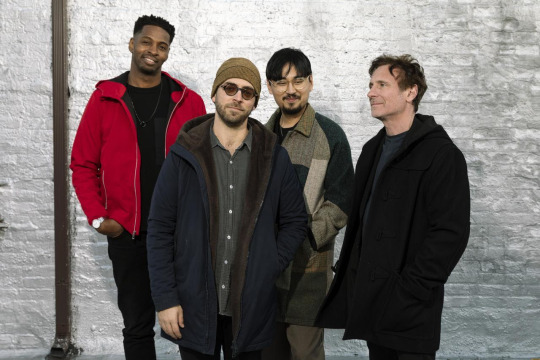
Photo by Anna Yatskevich
SILY: I take it you had most of the songs written and just added in improvisational elements during the recording.
AP: Exactly. By the time we hit the studio, we knew what we were doing, but there were a lot of things we hadn't decided upon at the beginning of the rehearsal week. A lot of my pieces, even in the studio, we went back and forth with compositional ideas, details of phrasing, or slight things in the form that only revealed themselves when we found it in the moment. I really love how the improvisation works on this record. On the earlier Little Big records, sometimes, it had a feeling of something I was trying to build or achieve, these songs of mine I was trying to bring out into the world. "Here's what I'm hearing, let's try to make it as close as we can to the ideal of it." There was a certain element of striving inside of [those records] that when it came to the improvisation, it could still be really cool, but there was something that felt at times like it was playing safe. We were so much focused on being able to build this thing that I wasn't allowing enough of the chaos energy to enter into it, for my own sake. Now that it feels much more alive, now that it feels like it's not mine, it feels a bit more thorny and dangerous when it needs and wants to be, and we're not getting in the way of that anymore. We're not forcing it to be exciting if it doesn't want to. It has less of a feeling of striving in any way. The songs are whatever they are.
SILY: There are moments where Greg's guitars are really scraggly, more so than usual, or there's a starkness to Jongkuk's drums. It doesn't really sound like you're trying to make a grand statement in the moment, you're just letting it be.
AP: On a tune like "Locked Down": That's a way I never would have allowed myself to play in the past, more angular, blurry, almost drunk-sounding. It's funny because this is the first Little Big record I was totally straight edge leading up to it and the recording. It was an interesting experience for me, because the previous two Little Big records were done on pretty heroic doses of mushrooms. This was definitely a cleaner vibe that actually sounded a little more intoxicated, in its own way.
SILY: This is your second Blue Note record as a band leader after Invisible Cinema, which is one of my favorite contemporary jazz records. Does this album have any sort of connection to that record?
AP: They're deeply connected. This band, Little Big, is taking some of those ideas I was looking after with Invisible Cinema and seeing whether I could boil [them] down a little bit more, in terms of feeling less stylistically grafted onto one another. Not jazz guys using rock ideas, but, "Can we have the improvisation and composition and mood and storytelling all start from the same center?" I still stand by [Invisible Cinema]. My playing on it sounds so youthful, scampering, in a way that sometimes, I'm like, "Oh boy, young man, chill out." [But it's faithful to the] idea of [allowing] so-called genres to really fuse with each other. That's one of the things I've been after with this band, allowing it to reduce to what is most essential. I've found that in some ways, the harmonic world of these songs has gotten much simpler and starker. How can I make the music that I'm playing sound to feel more like the music I most like to listen to?
SILY: And doing so in a way where parts of the process are out of your control.
AP: Exactly. It makes sense for this one to be coming back to Blue Note after all these years, the spiritual successor to the things I was after with Invisible Cinema years ago. It's looking at the same questions and finding different answers.
SILY: How do you approach storytelling with your music? Are there stories behind the songs, and what do you mean by "stories?"
AP: It's a funny thing, because I use that word a lot, and [the songs are] not necessarily concretely grounded. It's not a specific, actual story. They're not biographical--not most of them, anyways. There's another record that will come out next year [whose songs are based off] people, images, and dedications--not so much stories.
It's such a good question, and it's one I'm not sure I know how to answer, except for a feeling of narrative and folktale. I find myself drawn to myth and things that have been reduced into something that becomes totemic, in one way or another, and has a storytelling aspect that in some ways, is a specific story, and in other ways, is archetypical. I find myself drawn towards and often writing music that requires a sense of storytelling logic. What are the principles of the world of the song? How does gravity work in this environment? How do these different characters of the different leitmotifs relate to each other? Where might they culminate in surprising ways? As a composer, how can you withhold a part of the composition and have it emerge later on? A song like "Heart Stories" comes to mind. It's a lullaby. The first half of the song has a pathos.
SILY: There's a melancholy to it.
AP: That's the right word. There's a melancholy to it, especially the first half of it, that's a bit working with primary colors. It's simultaneously a lullaby and highly structured. It's mostly in various shades of blue at the beginning, you might say. Halfway through that song, the bottom falls out. It takes this narrative turn of leaving the question unanswered that it proposed, cutting you off in the middle, and putting you in a realm of more kaleidoscopic, more shifting emotions, more possibility. For me, it feels a little like you went from a sepia-toned thing to technicolor in the course of that song. That's a little bit on the simple side, but that's the kind of thing that comes to mind. It creates a feeling, that possibility of an emotional response in that moment--not an emotional response, hopefully, in a manipulative way, as that's not the goal either--allowing that story to unfold. That's as best as I can say it.
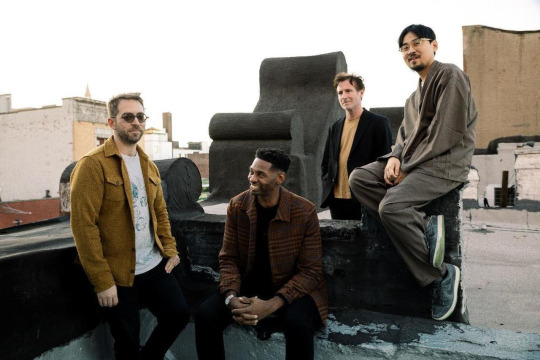
Photo by Anna Yatskevich
SILY: What went into the sequencing of the record? Was the process at all different from previous records?
AP: The process was just as obsessive and trying to create story with a sequence, as well, and simultaneously doing math because of vinyl. I was working on different sequences for a long time. This is the first Little Big record I don't wish we had done the sequence differently. The previous two records, I have strong feelings that I screwed up the sequence of it. I feel pretty strongly that this sequence is right. "Flyways" is the only way that the record can start. We tried a version that started with "Delusions", and it felt like a beatdown. To be perfectly frank, if I had a do-over, I wouldn't have picked "Delusions" as the lead single. Instead, it would be something even less representative of the record as a whole but very colorful and at the heart of the record, [like] "Little Beginnings".
[Though] "Flyways" for me works at the very beginning, there was something about it that felt a little bit too in common with the [opening song of the] second Little Big record, ["Attention, Earthlings"]. It felt a little bit like we were retreading familiar ground. The tunes are similar and different. They are both odd meter songs with tonal centers separated by a minor third. That's a lot. From there on, though, once [you] get into the heart of the record, each song as it comes along, you didn't see it coming but also feel that it was inevitable.
SILY: That's a common quality among my favorite records. Once I listen to it through all the way once, anything else wouldn't fit.
AP: Exactly. It was a puzzle putting this thing together and making it fit. The record is 42 minutes long, and we got it to 21 minutes each side, single vinyl. I was really happy we got it as short as we did, especially because the first two records were a bit on the bloated side. Single vinyl felt like the distillation. [David]'s tune "Little Beginnings" [is] right in the center of the record, I had asked him to write something for the band, and he wrote it right before we went into rehearsals. I can't imagine the record without it. It really does an important thing harmonically that adds a wider palate than the rest of the record has and showcases the chemistry of the band in real time, in a really special way.
Sequence is really interesting, and I'm glad you asked about it. It's something I put almost too much thought into. When the time is right, I will probably remix Little Big II and put it out again, because we did it in a hurry just before the pandemic. I'd like to put it out again with some bonus material, a different mix, and a different sequence. We didn't quite nail it.
#aaron parks#interviews#anna yatskevich#greg tuohey#shapeshifter lab#fortuna sung#dreamland recording#little big iii#little big#david ginyard jr.#jongkuk kim#blue note#blue note records#invisible cinema#matt garrison#jimmy garrison#find the way#ben street#billy hart#ecm#manfred eicher#don was#big thief#thomas morgan#little big ii#shapeshifter plus
0 notes
Text
To Dance and Sing, Meredith Monk on ECM

View On WordPress
#20th century#avant garde#California#Chamber music#Chicago#classical#Classical Music#Composers#contemporary music#ECM#experimental music#John cage#Manfred Eicher#Meredith Monk#minimalism#Modern Music#Music#New Music#Philip Glass#Piano#piano music#political music#Politics#Steve Reich
0 notes
Text

Stefano Bollani - Stone In The Water. 2009 : ECM.
4 notes
·
View notes
Video
youtube
Evgueni Galperine - "This Town Will Burn Before Dawn" (Theory Of Becoming).
Evgueni Galperine, a composer of Russian-Ukrainian origin based in Paris since 1990, released his debut album with ECM Records, Theory of Becoming, in 2022, noted for its originality and evocative nature. In this work, Galperine explores new forms of expression through sound, texture, and dynamics, creating an "augmented reality of acoustic instruments" by recording both real and virtual instruments. This technique allows him to capture the acoustic essence of the instruments while adding techniques and colors impossible to produce in reality.
The album addresses diverse themes, from the resilience of hope in the face of destruction to meditations on the journey of the soul, including travels through space and the magical forests of Max Ernst's paintings. Theory of Becoming was recorded and mixed between 2020 and 2021 in Paris, at Studio EPG and Studios de la Seine, under the production of Manfred Eicher.
The track "This Town Will Burn Before Dawn" stands out for its ability to immerse the listener in an introspective and emotionally charged atmosphere, reflecting Galperine's skill in innovatively blending acoustic and electronic elements. The composition is based on a harmonic progression in D minor (Dm), establishing a melancholic and reflective tone. Galperine employs a combination of acoustic instruments, such as the cello, and electronic textures to build sonic layers that evolve throughout the piece. The introduction presents a simple melody that gradually develops, incorporating additional elements that enrich the musical texture.
The harmony of the piece is characterized by the use of minor chords and subtle dissonances that add emotional depth. Galperine utilizes recording and sound processing techniques to transform acoustic instruments, creating an "augmented reality" that adds colors and techniques impossible to produce in reality. This sonic manipulation allows for the exploration of a wide range of timbres and dynamics, generating an immersive auditory experience.
Throughout the composition, the dynamics fluctuate between soft passages and moments of greater intensity, reflecting an implicit narrative that suggests a progression from calm to an emotional climax. The use of strategic silences and pauses helps create tension and anticipation, keeping the listener engaged with the evolution of the piece.
8 notes
·
View notes
Text
Exploring the Intimate Soundscapes of "Hotel Hello" by Gary Burton & Steve Swallow
Introduction: Gary Burton and Steve Swallow’s collaborative effort, “Hotel Hello,” stands as a testament to their musical synergy and innovative approach to jazz. Recorded in 1974 and released the following year on ECM Records, this album showcases the duo’s unique blend of vibraphone and bass, creating an intimate and introspective musical experience. Throughout the album, Burton seamlessly…
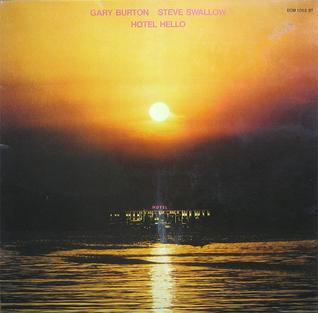
View On WordPress
#Carla Bley#Classic Albums#Gary Burton#Hotel Hello#Jack Gregg#Jazz History#Manfred Eicher#Mike Gibbs#Steve Swallow
3 notes
·
View notes
Text

Barbara Wojirsch (cover design), Dave Holland Quintet: ‘Seeds of Time’, ECM 1292, ECM Records, 1985 [Bibl.: ECM (Edition of Contemporary Music), Sleeves of Desire. A Cover Story, Texts by Peter Kemper, Peter Rüedi, Lars Müller, and Steve Lake, Lars Müller Publishers, Zürich, 1996, p. 311. Design: Lars Müller. Conception: Manfred Eicher, Lars Müller, Dieter Rehm, and Barbara Wojirsch]
2 notes
·
View notes
Video
youtube
Zsófia Boros - Le labyrinthe de Vermeer | ECM Records ( composed by Mathias Duplessy)
🎸 古典吉他 Classical Guitar || 出生於布拉格的匈牙利吉他手-索非亞· 波洛絲 Zsófia Boros/ Hungarian guitarist Zsófia Boros was born in Prague in 1980
“我經常認為音樂的選擇權掌握在自己手中,但後來我想知道音樂是否選擇了我作為媒介。 我的立意總是非常直覺; 當一首音樂抓住或觸動我時,我想反映它——成為一面鏡子並傳達它。 Often I think I am holding the choice of music in my own hands, but later I wonder if the music has chosen me as a medium. My approach is always very intuitive; when a piece of music grips or touches me, I want to reflect it – to become a mirror and convey it.”
-索非亞· 波洛絲 Zsófia Boros-
馬蒂亞斯·杜普萊西:維梅爾迷宮 · 索非亞 波洛絲 Duplessy: Le labyrinthe de Vermeer · Zsófia Boros · Mathias Duplessy
Producer: Manfred Eicher Studio Personnel, Recording Engineer, Mixer, Mastering Engineer: Stefano Amerio Composer: Mathias Duplessy
℗ 2023 ECM Records GmbH, under exclusive license to Deutsche Grammophon GmbH, Berlin
And 索非亞.波洛絲(Zsófia Boros)的專輯《最後的氣息》El Ultimo aliento (CD) 2023.
一則是來自阿根���的當代作曲,另一則是法國作曲家Mathias Duplessy的音樂。《Fanfare》雜誌對這位匈牙利籍吉他手給予了極高的評價,讚揚她「清晰優美的音色、流暢的演奏、精確的旋律與伴奏結合、靈活的裝飾音以及充滿情感的演繹」。這張專輯的名字取自Carlos Moscardini的作品,也是專輯的結尾曲 - El último aliento.
Boros在專輯中演繹了其他阿根廷作曲家如Joaquín Alem、Quique Sinesi和Alberto Ginastera的作品。在第七首的《Tormenta de ilusión》中,Boros換了來自安第斯地區的傳統撥弦樂器「Ronroco」。通過將阿根廷音樂與Duplessy的曲子相結合,以悄然方式創造出一個懸疑的專輯,突顯了她獨特的音樂風格。
#zsófia boros#索非亞· 波洛絲#mathias duplessy#le labyrinthe de vermeer#album - 最後的氣息 el ultimo aliento 2023#classical guitar 🎸
6 notes
·
View notes
Text

Jan Garbarek Quartet – Afric Pepperbird
from an album Afric Pepperbird (1970) “Garbarek combines the intensity of Albert Ayler and the economy of Dexter Gordon but reinscribes them with Nordic folkloric allusions, to produce, in producer Manfred Eicher’s words “an alternative to the American approach to jazz,” an approach he champions to this day.” – JazzWisee.
Jan Garbarek – tenor saxophone, bass saxophone Terje Rypdal – guitar Arild Andersen – double bass Jon Cristensen – percussion
3 notes
·
View notes
Text
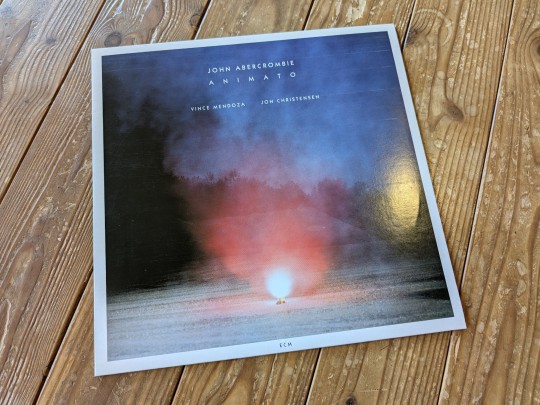
John Abercrombie
ANIMATO
0 notes